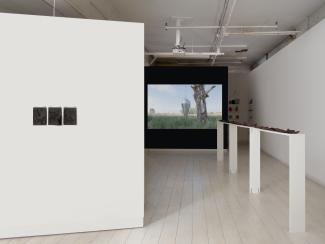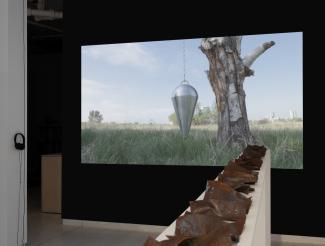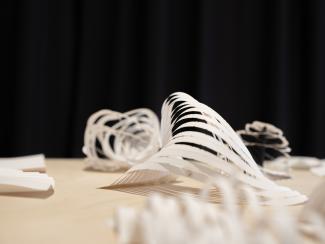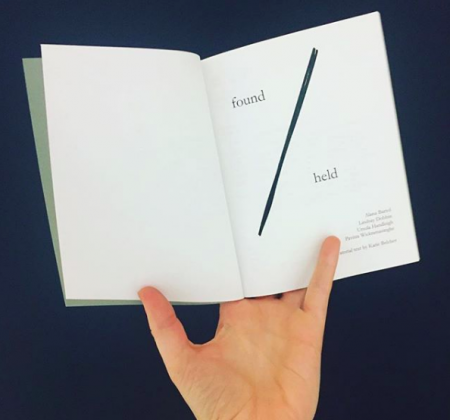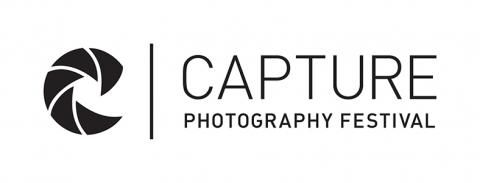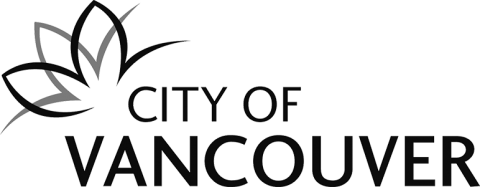found/held presents work by Alana Bartol, Lindsay Dobbin, Ursula Handleigh, and Pavitra Wickramasinghe in both an exhibition and accompanying publication. Acting as an extension of the exhibition and not wholly a record, this publication highlights aspects of the artists’ research, situating the exhibition in context of their larger practices. Taking capture as a point of departure, found/held treats photography not as a technical medium, but as a linguistic prompt.[1] Considering its etymology—photos + graphos—I invite you to situate these works in a conversation about drawing. As a practice, I liken drawing to language: always shifting, never complete, and continually confronting its own undoing. Each artist uses concrete materials—water, air, metal, paper—to capture phenomena—resonance, breath, energy, the fold.
drawing with light
drawing from a well
drawing breath
all sails drawing
drawing down the moon
found
With nods to science fiction, and disarming humour, Alana Bartol’s video, reading wild lands, re-imagines dowsing as a technology for remediation of land contaminated by the upstream oil and gas industry in Canada.[2] reading wild lands features site readings performed by Bartol on two former oil refinery sites in Calgary, each undergoing or having undergone processes of remediation.[3] In a 2019 exhibition text, curator Jacqueline Bell observes, “The areas' verdant grasslands and vegetation belie their history as former industrial sites, a disjuncture that highlights the perpetual yet often overlooked presence of industry within the quotidian spaces of urban life.”[4] This video, and the associated sculptural and performative works, draw directly from another of Bartol’s projects, The Orphan Well Adoption Agency, in which she invites the public to become caretakers of abandoned orphan wells.[5] This publication includes striking portraits of the solitary wells and their correspondence to the caretakers.
Challenged as to its scientific validity, dowsing is a form of divination used to locate myriad information including ground water, metals, and oil. Also known as water-witching—or with respect to oil, doodlebugging—the practice is predicated on the dowser’s being attuned to the locale in question. Considering dowsing to be a practice of listening to the site itself, Bartol explains, “In this work I am thinking a lot about how I (and other settler Canadians) are implicated in systems of oppression—organized around white settler colonialism, patriarchy, and capitalism—that are intertwined with environmental degradation, indigenous dispossession, and colonial violence.” Complicating her familial history as both settlers and water-witches, Bartol’s employment of this practice is deliberate. She is earnest in her care of these spaces, and uses the practice’s controversy to highlight the absurdity of the task. “In her work dowsing is a means for reconsidering consumption-driven relationships to the land and natural resources (a term that she points out implies that things like water, oil and minerals exist solely for human consumption and exploitation). Instead she asks if it is possible that elements like water, minerals and oil have their own agency.”[6] Bartol’s performances privilege a practice disregarded by the same science that attempts—perhaps in as much vain—to remedy destructive environmental effects whilst nonetheless building new wells.
held
Lindsay Dobbin’s practice of deep listening, and sustained engagement with the Bay of Fundy is reflected in Arrival, in which they build a spacious soundscape with two tones acting as wave cycles. This sound piece results from Dobbin’s performance, Drumming the Tide, which they describe as a “six hour intertidal drumming pilgrimage.”[7] The performance took place in August 2014, when the tides were reaching their highest in a 28-year cycle. Beginning at the water’s edge, Dobbin struck their handmade drum each time the advancing tide met their body, and took a step forward toward the shore. Dobbin explains, “from low to high tide, these very simple and humble gestures grounded me in the experience as I became aligned with the (im)pulse of the ocean, entering a deep state of awareness where the rhythm was slow, cyclical and powerful.”[8]
At the end of the six hour performance, I removed the white cape that I had been wearing, and watched it float off and away into the ocean. A few days after returning to the Bay of Fundy a year later, I was exploring the intertidal zone, collecting mud to dye paper. As I dug, I came across a piece of fabric. As I removed the mud from it, I realized it was the cape I had worn for Drumming the Tide. It spent a year in the ocean, and the sea gave it back to me.[9]
Held by an immense basin of red earth, the tides of the Bay of Fundy are the highest in the world, ranging in differences between low and high tides of 3.5 to 16 metres. The speed at which these 160 billion tonnes of seawater flow in and out of the basin is so perceptible that in certain inlets I’ve had to drastically quicken my steps to outpace the water’s advance. I was a witness to Dobbin’s performance, during which as the tide approached a narrowing landscape, it overtook them despite Dobbin maintaining a constant pace. By the end of the performance, Dobbin was carried to shore, submerged to their neck. With Arrival, Dobbin aims to translate this experience to sound. They ask only that we listen, and through a sustained resonance, we can for a moment experience the pacing, immersion, and ritual of their experience with this place.
Ursula Handleigh uses camera-less photography and alternative experiential processes of image-making to record personal histories. I can feel you forgetting is a series of contact prints of breath. After carrying a piece of photographic paper on a daily journey to the Atlantic Ocean, Handleigh spoke into the paper at the water’s edge before submerging it in the ocean. Fixed by sea water, the resulting images—like those that appear in this publication—capture both the impressions of her hands and the humidity of her breath. She then transferred these images onto steel.
These photographic plates make visible the materiality of their surroundings. As living photographs, the plates continue to rust over the course of the exhibition, essentially breathing oxygen from their environment as they form iron-oxide. By collapsing a durational experience into a single image, each photograph “counter[s] the photographic instant, expanding the fractional moment into a document of elongated time...capturing a fleeting moment, always in the process of disappearance, always failing in its attempt to preserve.”[10] Tellingly, Handleigh’s language in describing her work advances and recedes like the littoral spaces that are as much a part of her practice as is her breath. Relying on water to form a conceptual bridge between place and time, she retraces the elusive moments of her past, in her words, “recording stories that have been passed to me only through memory, of my ancestors whom I never met and were never documented.”[11]
The cognitive map is now understood to have its own physical location, as a collection of electrochemical firings in the brain…The discovery that human orientation takes place in memory’s seat — researchers have long known that damage to the hippocampus can cause amnesia — has raised the tantalizing prospect of a link between the two.[12]
fold
A dialectic of the interior/exterior is evident in all four artist’s works. We watch as a subsurface energy animates Bartol’s iron filings in reading wild lands. The tension is evident in the surface of Dobbin’s drum, the containment of the Fundy, and the interior experience of our own listening to Arrival. We subvert this boundary as we add our own inhalations and exhalations while viewing I can feel you forgetting. This false duality is further complicated by the folding, crumpling, unfolding, and refolding in both Wickramasinghe’s and Handleigh’s work.[13]
Of working with paper, Pavitra Wickramasinghe says “it is versatile, egalitarian, identifiable, and a simple everyday material that is both intimate and generic.” Through her material and technical choices—folding, laser and hand-cutting—Wickramasinghe creates forms that are both strong and malleable. She is particularly interested in how the origami Miura fold—which uses creases in parallelograms to fold a flat piece of paper into a compact shape—can expand and contract like the surface of the ocean. With these wave patterns, she aims to prompt in the viewer a sense of being in more than one place at once, describing the sea as “an in-between place and a path to elsewhere.”[14]
Inspired by reading about the disappearing skill of wave pilots in the Marshall Islands—specially trained in the ancient art of reading wave patterns—Coral bones/La mer is a return to these innate navigation skills and of the body to the environment. She says, “our capacity for orientation not only allows us to navigate our surroundings; it also influences our sense of place, home and even our sense of self… Humanity has managed to travel the world and even into outer space using technology in defiance of our innate navigation skills and in a sense removing the body out of the environment.”[15]
Swells generated by distant storms near Alaska, Antarctica, California and Indonesia travel thousands of miles to [the Marshall Islands’] low-lying spits of sand. When they hit, part of their energy is reflected back out to sea in arcs, like sound waves emanating from a speaker; another part curls around the atoll or island and creates a confused chop in its lee. Wave-piloting is the art of reading — by feel and by sight — these and other patterns.
… theoretically, a wave-pilot, dropped blindfolded into a boat in Marshallese waters, could follow a set of seamarks — waves of a particular shape — alone to land.[16]
Wickramasinghe’s folding highlight the continuity of the sea; as much bound to a continuous energy as it is unbound in its expanse. Wickramasinghe’s paper works are akin to the wave patterns themselves, made of two surfaces that never cross, but rather continue to fold in on themselves. Deleuze describes this cohesion in The Fold (Le pli), “…the labyrinth of continuity is not a line which would dissolve into independent points, like sand flowing in grains, but is like a piece of fabric or a sheet of paper which divides into an infinite number of folds or disintegrates into curved movements, each one determined by the consistency or the participation of its setting.”[17]
The artists in found/held make various attempts to record, align, map, trace, collect, maintain, care, and experience, sharing a phenomenological journey. Through varying materials as both subject and medium, each artist draws on a connection to the elemental experience of place—Bartol’s site readings, Dobbin’s attuned pacing, Handleigh’s collected breath, and Wickramasinghe’s mirroring of the waves’ reverberation against land. Ultimately, they ask us for our time, inviting us to consider the passage of energy from storm to shoreline; to be submerged by tonal intersections; to acknowledge our impact; and to materialize time spent.
Katie Belcher, curator
[1] Capture, Vancouver’s Photography Festival during which this exhibition was on view.
[2] The petroleum industry is divided into three major components, ironically employing terms typically used to describe waterways: upstream, midstream and downstream. The upstream industry finds and produces crude oil and natural gas.
[3] Inglewood Wildlands and Refinery Park (Calgary AB)
[4] Bell, Jacquelin, excerpt from If the river ran upwards exhibition text 2018, Walter Phillips Gallery (Banff, AB)
[5] “In the upstream oil and gas industry, an orphan is a well, pipeline, facility or associated site which has been investigated and confirmed as not having any legally responsible and/or financially able party to deal with its abandonment and reclamation responsibilities.” http://www.orphanwell.ca/faq/
[6] Sheppard, Lou. watching, listening, seeing, hearing: tectonic shift at the museum of the flat earth, curated by Kay Burns, 2018.
[7] Dobbin, Lindsay. www.lindsaydobbin.com/drumming-the-tide/ accessed 13 February 2019.
[8] Dobbin, Lindsay. www.lindsaydobbin.com/drumming-the-tide/ accessed 13 February 2019.
[9] Dobbin, Lindsay. www.lindsaydobbin.com//body-sail/ accessed 15 February 2019.
[10] Handleigh, Ursula. Towards an Anthology of Memory: A Thesis Presented to the Nova Scotia College of Art and Design University in companion to the exhibition I can feel you forgetting. Master of Fine Arts April 2017. pp14-15
[11] Handleigh, Ursula. I can feel you forgetting. Anna Leonowens Gallery, April 2017.
[12] Tingley, Kim. “The Secrets of the Wave Pilots,” The New York Times 20 Mar. 2016: MM52. Web. 13 Mar. 2017. accessed 13 February 2019
[13] Deleuze, Gilles, and Jonathan Strauss. pp 227, Note 1: Deleuze distinguishes, not entirely consistently, between the “replis” of inorganic matter and the “plis” of the organic. “Pli” and “repli” both have a primary meaning of “fold” and are otherwise largely synonymous, although the form of the latter suggests and idea of repetition. An introverted person is furthermore said to be “replié sure soi,” and the word “repli” consequently has a connotation of turning inward, or invagination. - Translator’s Note.
[14] Wickramasinghe, Pavitra. Statement about Coral bones/La mer, 2018.
[15] Wickramasinghe, Pavitra.
[16] Tingley, Kim.
[17] Deleuze, Gilles, and Jonathan Strauss. pp 231
